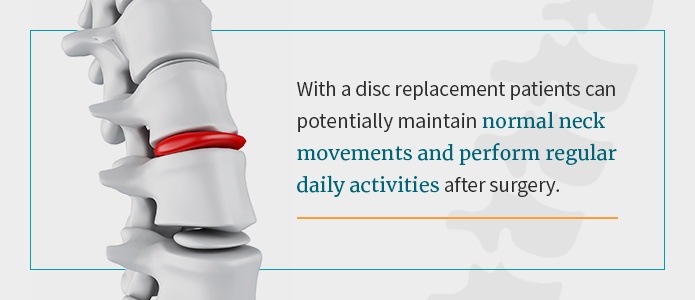In this article:
- What Is Cervical Spinal Fusion?
- What Can I Expect After a Spinal Fusion?
- What Are the Benefits of Cervical Fusion?
- What Is Disc Replacement?
- What Are the Benefits of Disc Replacement?
- Disc Replacement Surgery vs Fusion
- OIP Back Pain Specialists
Neck pain is never easy to live with. Any pain in the back or neck can make daily activities difficult. About 80% of people will experience neck pain in their lifetime, and up to half of them cope with this ailment every year. While neck discomfort is rarely a sign of a serious condition and usually improves over time, it may require surgical intervention if the pain persists.
Spinal surgery in the neck region may involve a bone fusion or disc replacement, depending on your condition and other factors. We’ll explore the differences between cervical fusion and disc replacement to help you weigh your options. If you have any questions along the way, reach out to us at the Orthopedic Institute of Pennsylvania (OIP), where a member of our team will be waiting to assist you.
What Is Cervical Spinal Fusion?
Spinal fusion is a surgery that connects two or more bones, called vertebrae, in the spine. Cervical fusion joins the vertebrae in the neck region of the spine. By fusing two or more bones together, the vertebrae can no longer move abnormally, ideally improving spine stability and reducing pain.
What Causes Cervical Pain?
The cervical spine contains seven vertebrae, which are separated by discs. The intervertebral discs act like shock-absorbing cushions and keep the vertebrae from touching each other. They also help hold the vertebrae together. Sometimes, the discs break down and can no longer function as they should. This may lead to pain in the cervical spine region. Other possible causes of neck pain include the narrowing of the spine canal or arthritis.
Why Would You Have a Cervical Fusion?
Most patients who experience neck pain do not need surgery, and your doctor will likely recommend other treatment methods first. However, if your neck pain does not improve without an operation, your doctor may suggest cervical fusion.
A surgeon might perform a spinal fusion after removing a herniated or damaged disc to improve spine stability or to treat a spinal deformity or injury.
What Happens During Spinal Fusion Surgery?
There are several different techniques used to perform spinal fusion surgery. Your surgeon would consider the location of your pain and the reason for the operation when selecting the best method for you.
In general, patients are first given anesthesia, so they don’t feel any pain throughout the procedure. Next, the surgeon will make an incision so they can access the vertebrae. They will then place a bone graft between the vertebrae, which will fuse the bones as they heal. Sometimes a surgeon will use a synthetic material to join the vertebrae, rather than a bone graft.
Most modern spinal fusions are minimally invasive and can be performed with small incisions.
What Can I Expect After a Spinal Fusion?
Typically, a spinal fusion requires two to three days in the hospital so your doctor can monitor your recovery and reaction to the surgery. Some patients may experience discomfort after their surgery, which doctors can usually control with pain medication. Overall, it can take a few months for the vertebrae to fuse and heal. Your doctor may recommend wearing a brace during your recovery to keep the spine aligned.
What Are the Benefits of Cervical Fusion?

Cervical fusion surgery can potentially reduce back pain and improve a patient’s quality of life. In particular, anterior cervical discectomy and fusion, or ACDF, has a high success rate. This procedure involves removing a herniated disc from the neck region and then fusing the vertebrae together, accessing the spine through the front of the neck, instead of the back. According to a study published by the National Institutes of Health, the majority of patients reported a successful ACDF procedure.
What Are the Risks?
Cervical fusion is generally safe, and complications are uncommon. However, as with any surgery, it carries the risk of infection, poor healing or a reaction to anesthesia. Your doctor will weigh the pros and cons to determine if cervical fusion is right for you.
What Is Disc Replacement?
Cervical disc replacement is a new surgical procedure and a promising alternative to cervical fusion. With this procedure, the surgeon removes the damaged intervertebral disc and replaces it with an artificial one. Unlike cervical fusion, disc replacement does not involve welding bones together.
What Happens During Cervical Disc Replacement?
Similar to cervical fusion, a patient will first be given anesthesia. The surgeon will then make a small incision on the front or side of the neck. Next, the surgeon will remove the damaged cervical disc and securely place an artificial disc into the space. They will then carefully close the incision with sutures.
What Are the Benefits of Disc Replacement?

One of the main benefits of disc replacement is increased spine mobility. A disc replacement is meant to mimic the function of a healthy disc, which means patients can potentially maintain normal neck movements and perform regular daily activities after surgery.
What Are the Risks of Disc Replacement Surgery?
A disc replacement procedure is generally safe but includes the potential dangers of any spine surgery, such as a risk of infection, excessive bleeding or a reaction to the anesthesia. Another potential risk of disc replacement is an allergic reaction to the implant. Your doctor will evaluate your condition and talk with you to determine if the benefits outweigh the risks.
Disc Replacement Surgery vs Fusion
Since disc replacement is a relatively new surgery, there’s not a lot of information on the long-term outcomes yet. However, there are known advantages that may make it a better alternative than cervical fusion for some patients. Some known benefits of disc replacement are that it:
- Allows greater movement: Disc replacements are designed to function like your body’s natural discs. This may enable greater spine mobility and allow you to move as you would normally. Cervical fusion, on the other hand, welds bones together and eliminates movement in the affected area of the spine.
- Creates less stress on other spinal bones: If a disc replacement allows more movement, it will put less stress on the vertebrae located below and above the artificial disc. Without the added pressure on other vertebrae, patients could expect a reduced risk of further disc degeneration in the future. According to a meta-analysis from 2017, disc replacement improves secondary surgical procedure reduction.
- Yields a faster recovery time: It usually takes several months for a patient to recover from a spinal fusion and get back to their regular activities. Alternatively, the recovery time for a disc replacement is typically much faster, because a patient does not have to wait for their bones to fuse. Patients who undergo a disc replacement procedure should be able to resume normal activities within four to six weeks. Lumbar disc replacement, a similar procedure that replaces the discs in the lower back, also has a faster recovery time than fusion. A study published in Global Spine Journal found that disc replacement patients were able to return to work significantly faster than fusion patients.
Although there are advantages to disc replacement over cervical fusion, not every patient is a good candidate for this type of spinal surgery. After an evaluation, your doctor will discuss the best option for your unique needs.
Contact OIP for More Information from our Back Pain Specialists
If you are considering spinal disc replacement surgery vs cervical fusion, your doctor will determine if surgery is right for you. Although surgery can help improve the quality of life for some patients with persistent back or neck pain, it’s usually not necessary. Generally, surgery is a last resort, and there are better options available.
If you’re unable to cope with your neck or back pain, reach out to us at OIP. Our spine and back pain specialists will use state-of-the-art tools to diagnose the source of your pain and determine the best treatment for you. To learn more about spine care and how we can help, contact us today or request an appointment.



